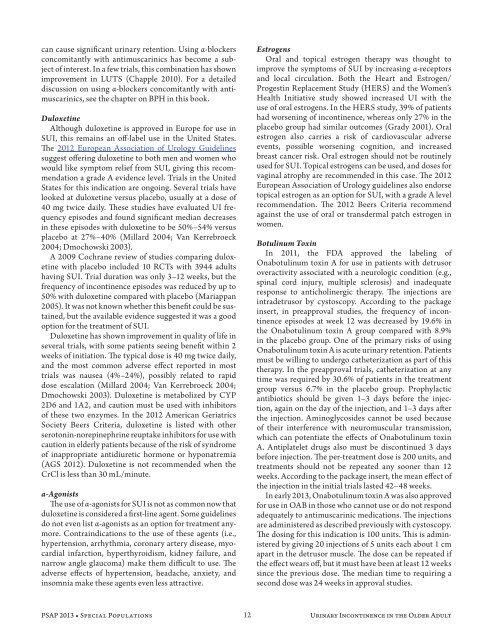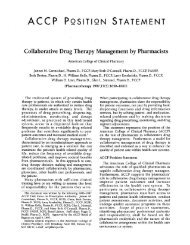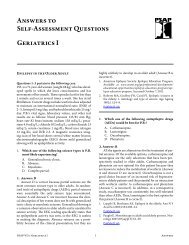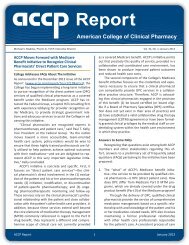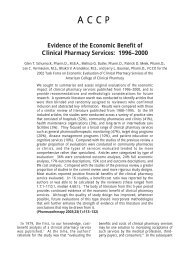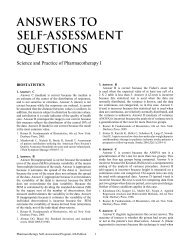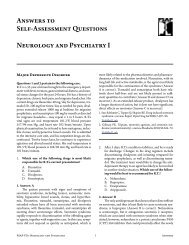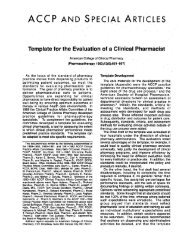Sample PDF - ACCP
Sample PDF - ACCP
Sample PDF - ACCP
You also want an ePaper? Increase the reach of your titles
YUMPU automatically turns print PDFs into web optimized ePapers that Google loves.
can cause significant urinary retention. Using α-blockers<br />
concomitantly with antimuscarinics has become a subject<br />
of interest. In a few trials, this combination has shown<br />
improvement in LUTS (Chapple 2010). For a detailed<br />
discussion on using α-blockers concomitantly with antimuscarinics,<br />
see the chapter on BPH in this book.<br />
Duloxetine<br />
Although duloxetine is approved in Europe for use in<br />
SUI, this remains an off-label use in the United States.<br />
The 2012 European Association of Urology Guidelines<br />
suggest offering duloxetine to both men and women who<br />
would like symptom relief from SUI, giving this recommendation<br />
a grade A evidence level. Trials in the United<br />
States for this indication are ongoing. Several trials have<br />
looked at duloxetine versus placebo, usually at a dose of<br />
40 mg twice daily. These studies have evaluated UI frequency<br />
episodes and found significant median decreases<br />
in these episodes with duloxetine to be 50%–54% versus<br />
placebo at 27%–40% (Millard 2004; Van Kerrebroeck<br />
2004; Dmochowski 2003).<br />
A 2009 Cochrane review of studies comparing duloxetine<br />
with placebo included 10 RCTs with 3944 adults<br />
having SUI. Trial duration was only 3–12 weeks, but the<br />
frequency of incontinence episodes was reduced by up to<br />
50% with duloxetine compared with placebo (Mariappan<br />
2005). It was not known whether this benefit could be sustained,<br />
but the available evidence suggested it was a good<br />
option for the treatment of SUI.<br />
Duloxetine has shown improvement in quality of life in<br />
several trials, with some patients seeing benefit within 2<br />
weeks of initiation. The typical dose is 40 mg twice daily,<br />
and the most common adverse effect reported in most<br />
trials was nausea (4%–24%), possibly related to rapid<br />
dose escalation (Millard 2004; Van Kerrebroeck 2004;<br />
Dmochowski 2003). Duloxetine is metabolized by CYP<br />
2D6 and 1A2, and caution must be used with inhibitors<br />
of these two enzymes. In the 2012 American Geriatrics<br />
Society Beers Criteria, duloxetine is listed with other<br />
serotonin-norepinephrine reuptake inhibitors for use with<br />
caution in elderly patients because of the risk of syndrome<br />
of inappropriate antidiuretic hormone or hyponatremia<br />
(AGS 2012). Duloxetine is not recommended when the<br />
CrCl is less than 30 mL/minute.<br />
α-Agonists<br />
The use of α-agonists for SUI is not as common now that<br />
duloxetine is considered a first-line agent. Some guidelines<br />
do not even list α-agonists as an option for treatment anymore.<br />
Contraindications to the use of these agents (i.e.,<br />
hypertension, arrhythmia, coronary artery disease, myocardial<br />
infarction, hyperthyroidism, kidney failure, and<br />
narrow angle glaucoma) make them difficult to use. The<br />
adverse effects of hypertension, headache, anxiety, and<br />
insomnia make these agents even less attractive.<br />
Estrogens<br />
Oral and topical estrogen therapy was thought to<br />
improve the symptoms of SUI by increasing α-receptors<br />
and local circulation. Both the Heart and Estrogen/<br />
Progestin Replacement Study (HERS) and the Women’s<br />
Health Initiative study showed increased UI with the<br />
use of oral estrogens. In the HERS study, 39% of patients<br />
had worsening of incontinence, whereas only 27% in the<br />
placebo group had similar outcomes (Grady 2001). Oral<br />
estrogen also carries a risk of cardiovascular adverse<br />
events, possible worsening cognition, and increased<br />
breast cancer risk. Oral estrogen should not be routinely<br />
used for SUI. Topical estrogens can be used, and doses for<br />
vaginal atrophy are recommended in this case. The 2012<br />
European Association of Urology guidelines also endorse<br />
topical estrogen as an option for SUI, with a grade A level<br />
recommendation. The 2012 Beers Criteria recommend<br />
against the use of oral or transdermal patch estrogen in<br />
women.<br />
Botulinum Toxin<br />
In 2011, the FDA approved the labeling of<br />
Onabotulinum toxin A for use in patients with detrusor<br />
overactivity associated with a neurologic condition (e.g.,<br />
spinal cord injury, multiple sclerosis) and inadequate<br />
response to anticholinergic therapy. The injections are<br />
intradetrusor by cystoscopy. According to the package<br />
insert, in preapproval studies, the frequency of incontinence<br />
episodes at week 12 was decreased by 19.6% in<br />
the Onabotulinum toxin A group compared with 8.9%<br />
in the placebo group. One of the primary risks of using<br />
Onabotulinum toxin A is acute urinary retention. Patients<br />
must be willing to undergo catheterization as part of this<br />
therapy. In the preapproval trials, catheterization at any<br />
time was required by 30.6% of patients in the treatment<br />
group versus 6.7% in the placebo group. Prophylactic<br />
antibiotics should be given 1–3 days before the injection,<br />
again on the day of the injection, and 1–3 days after<br />
the injection. Aminoglycosides cannot be used because<br />
of their interference with neuromuscular transmission,<br />
which can potentiate the effects of Onabotulinum toxin<br />
A. Antiplatelet drugs also must be discontinued 3 days<br />
before injection. The per-treatment dose is 200 units, and<br />
treatments should not be repeated any sooner than 12<br />
weeks. According to the package insert, the mean effect of<br />
the injection in the initial trials lasted 42–48 weeks.<br />
In early 2013, Onabotulinum toxin A was also approved<br />
for use in OAB in those who cannot use or do not respond<br />
adequately to antimuscarinic medications. The injections<br />
are administered as described previously with cystoscopy.<br />
The dosing for this indication is 100 units. This is administered<br />
by giving 20 injections of 5 units each about 1 cm<br />
apart in the detrusor muscle. The dose can be repeated if<br />
the effect wears off, but it must have been at least 12 weeks<br />
since the previous dose. The median time to requiring a<br />
second dose was 24 weeks in approval studies.<br />
PSAP 2013 • Special Populations 12 Urinary Incontinence in the Older Adult


